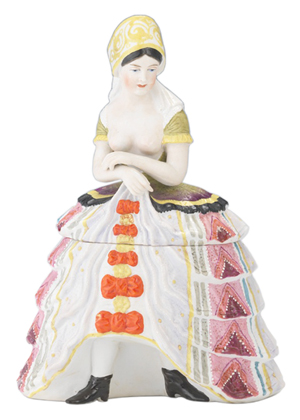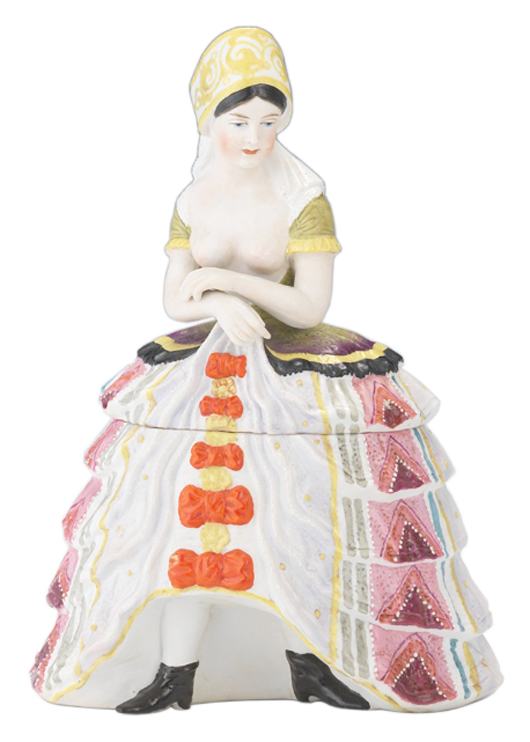
Why would a tobacco jar from the 19th century be shaped like a lady in a long, full dress? Tobacco jars were made in many unexpected shapes, and there are many figural tobacco-jar collectors today. Most jars were made from 1850 to 1900 in Bohemia and nearby countries. They were made of majolica, bisque, pottery, wood, even bronze. Most common today are “heads.” Life-like heads of men, women, children, ethnic groups, animals and even a rare fish were made. “Full figurals” were made that looked like 19th-century ladies, historic figures, peasants, sailors and animals in suits or dresses. There was humor seen in many of the jars, some very subtle. The lady in a full skirt looks demure and proper, but her ankles are showing below the hem of her skirt. She is flirting. In those days, an ankle was considered erotic. Today, it takes more than a lifted skirt; girls wear ankle bracelets or tattoos to show off a pretty ankle. Figural jars cost hundreds of dollars today.
Q: I have a pair of heavy bookends with figures of a Chinese boy and girl. The boy is standing on a couple of books and looking over the top of another book. The girl is sitting on two books and reading a book. One bookend says “Fashioned by Ronson” and the other is labeled “Ronson All Metal Art Wares.” It also says “Royal Old Gold.” The figures are gold, and the books are black with gold edges. Can you tell me something about them and what they are worth?
A: Ronson was founded in New York by Louis V. Aronson in 1886. The company moved to New Jersey in 1887. Ronson is best known for its cigar and cigarette lighters, but it also made ashtrays, bookends, busts, desk sets, fraternal and religious items, lamps, medals, picture frames, toys, and many other things. Your bookends were made in the 1930s. Similar bookends were made with Dutch children. Zippo Manufacturing Co. bought most of the Ronson assets in 2010. Value of your set: $125.
Q: I have several pieces of my mother’s Guardian Ware cookware, including three triangle pots with lids and a large roaster pan with a lid. What are the pieces worth?
A: Guardian Ware, also called Guardian Service cookware, was made by Century Metalcraft Corp. of Los Angeles from the 1930s until 1956, when the factory burned down. Pieces were sold at in-home parties the way Tupperware was later sold. Guardian Ware was made of heavy-duty hammered aluminum. Before World War II, the ware’s high-domed lids were metal. Because of metal shortages during the war, the company started making oven-proof glass lids. Your triangle pots were designed to be used as a set on a trivet that sat on a burner. That way, three different vegetables could be cooked at the same time. Guardian Ware is a popular collectible today. Pieces sell online for $5 to $150. Sets can sell for several hundred dollars.
Q: My in-laws left an Abraham Lincoln picture to us, and we’re wondering what it’s worth. It’s mounted in a carved oval wooden frame. The president is on the right sitting in a chair facing left and holding an open book in his lap. Mrs. Lincoln is in a chair on the left and is facing right holding a closed book in her left hand. The Lincolns’ oldest son, Robert, is standing behind his mother’s chair. Their youngest son, Tad, is standing close to his father. A portrait of son Willie, who died in 1862, is hanging on the wall behind the president. There’s a small typed memo on the back of the picture. It says: “Eng’d by A. Robin, NY, Entered according to act of Congress in the year 1869 by G.W. Massee in the Clerks office of the District Court of the Eastern District of Pennsylvania.” What is the picture worth, and how can I sell it? Should we reframe it?
A: What you own is a print made from an engraving. After Abraham Lincoln was assassinated in 1865, the public clamored for Lincoln memorial souvenirs. Augustus Robin, a New York engraver, used a Matthew Brady photograph of Lincoln and Tad as a model to create a steel engraving of the family. The engraving was used by G.W. Massee, a Philadelphia printer, to make copies that could be sold to the public. You own one of Massee’s prints. Many were probably made, but it’s not likely that many have survived for 150 years. The frame may be original, so don’t reframe it. If you want to sell it, you can try online. It might sell for about $100.
Tip: To clean old paper, try talcum powder. Take a soft brush or powder puff, sprinkle on the powder, leave for an hour, and brush it off.
Terry Kovel answers as many questions as possible through the column. By sending a letter with a question, you give full permission for use in the column or any other Kovel forum. Names, addresses or email addresses will not be published. We cannot guarantee the return of any photograph, but if a stamped envelope is included, we will try. The volume of mail makes personal answers or appraisals impossible. Write to Kovels, Auction Central News, King Features Syndicate, 300 W. 57th St., New York, NY 10019.
CURRENT PRICES
Current prices are recorded from antiques shows, flea markets, sales and auctions throughout the United States. Prices vary in different locations because of local economic conditions.
- Little Cub Scout book, by Mabel Watts, illustrated by William Timmins, Rand McNally Elf Book, 1964, $20.
- Dole “Banana Man” doll, inflatable plastic, long legs, red sneakers, white gloves, product premium, sealed, original bag, 8 x 8 inches, $65.
- Beswick Beatrix Potter figurine, Goody Tiptoes, squirrel holding basket of yellow nuts, marked, 1974-85, 3 1/2 inches, $75.
- Old Dutch Cleanser hooked rug, store promotion, woman holding stick, yellow ground, half circle, 1930s, 17 1/2 x 29 inches, $95.
- Glass luncheon plates, Hobnail pattern, blue opalescent, Fenton Art Glass Co., 6 inches, set of six, $115.
- Italian Family Cooking cookbook, by Edward Giobbi, illustrated, first edition, 1971, 252 pages, $145.
- Twiggy doll, shaggy blond hair, black lashes, pink lips, open mouth, Twigster dress, orange and yellow, checked knit top, striped bottom, scarf, Mattel, 1967, 11 1/2 inches, $165.
- Tiffany & Co. ring box, figural apple, sterling silver, gilt interior, signed, 1960s, 2 1/4 x 1 1/3 inches, $200.
- Faux bamboo corner shelf, four shelves, mottled, spindle gallery, scalloped edges, circa 1900, 51 x 23 x 19 inches, $210.
- Darky and Cabin mechanical bank, cast iron, figure stands in doorway, slot on roof, J. & E. Stevens, 1880s, 3 3/4 x 4 1/4 inches, $1,295.
Order the set: “Buyers’ Guide to 20th Century Costume Jewelry,” Part One and Part Two. Both for our special price of $34.95. These special reports help you identify the most popular makers and designers of costume jewelry. Spot mid-century costume jewelry, Mexican silver jewelry and European and North American pieces. Learn who Hobe and Sigi are and how to recognize a rare piece of Bakelite. Accurate, comprehensive and valuable whether you’re a serious collector or just a beginner. Available only from Kovels. Order by phone at 800-303-1996; online at Kovels.com; or send $34.95 plus $4.95 postage and handling to Kovels, P.O. Box 22900, Beachwood, OH 44122.
© 2012 by Cowles Syndicate Inc.

ADDITIONAL IMAGE OF NOTE



